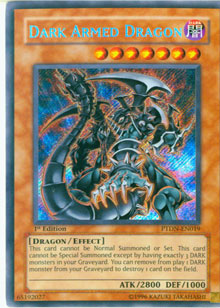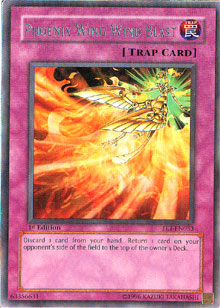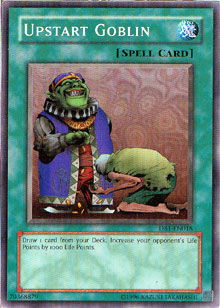 As a player, this format has been one of the most thrilling to be a part of. Gladiator Beasts and Dark Armed Return are duking it out for top honors, and to the most prepared player go the spoils. The format is clearly defined, and all one has to do to emerge victorious is to have a powerful deck, a strong and consistent play style, and a little luck. It is possible for either of the top decks to draw nearly unstoppable hands, and unless you draw that perfect counter hand, you’ll stand no chance. That’s what leads many players to attempt alternative strategies. Going with luck isn’t going to take you to Day 2 all the time, so players constantly look for new ways to get ahead of the competition.
As a player, this format has been one of the most thrilling to be a part of. Gladiator Beasts and Dark Armed Return are duking it out for top honors, and to the most prepared player go the spoils. The format is clearly defined, and all one has to do to emerge victorious is to have a powerful deck, a strong and consistent play style, and a little luck. It is possible for either of the top decks to draw nearly unstoppable hands, and unless you draw that perfect counter hand, you’ll stand no chance. That’s what leads many players to attempt alternative strategies. Going with luck isn’t going to take you to Day 2 all the time, so players constantly look for new ways to get ahead of the competition.
Chris Bowling is one duelist who’s seen a lot of success this format. Similar to the path Paul Levitin made back in 2005, Bowling has made several impressive showings, diving deeply into Day 2 and taking home a national title. The reason is that every single time he’s made Day 2, he has a better deck than most of the competition. With a better deck, Bowling can flex his skills and win almost all his games.
The deck he ran at the Shonen Jump Championship in Honolulu was a variant on the deck Zaki Said brought to SJC Philly. At one of the hardest tournaments on the circuit, Zaki boasted an impressive 8-2 performance, sadly losing out on a Top 16 spot on tiebreakers. His deck created quite a stir though. Zaki was running a modified Dark Armed Dragon build given to him by Shane Scurry. The idea was to have an incredible amount of draw power. By filling a deck with only draw power, power cards, and support, one could theoretically draw into amazing hands very consistently. Considering that there are so many game-changing power cards these days, being able to draw out three-quarters or all of your deck is something that can’t be taken lightly.
Chris Bowling clearly took notice of Zaki’s performance and his deck, because the very next weekend in Honolulu Bowling took the deck to a Top 8 finish, losing to the eventual champion Mario Matheu. Here’s what he ran:

Monsters: 15
1 Destiny Hero - Disk Commander
1 Destiny Hero - Fear Monger
3 Destiny Hero - Plasma
2 Dark Armed Dragon
2 Cyber Valley
1 Dark Grepher
1 Morphing Jar
1 Sangan
1 Dark Magician of Chaos
1 D.D. Crow
Spells: 17
3 Upstart Goblin
3 Destiny Draw
2 Allure of Darkness
2 Trade-In
Traps: 8
1 Crush Card Virus
1 Torrential Tribute
1 Trap Dustshoot
2 Phoenix Wing Wind Blast
3 Solemn Judgment
The deck looks ugly at first, doesn’t it? I take a look at the list and I think, "Okay, so it can draw lots of cards and I guess if given the right stuff can OTK sometimes." I thought the same thing when I first looked at T-Hero. What most people don’t realize is how well drawing lots of cards—and more importantly, cycling cards to the graveyard with Destiny Draw and Trade-In—improves the chances of drawing an OTK or crippling hand.
Chris Bowling clearly isn’t playing as much for the OTK as T-Hero was. There’s no Limiter Removal or  , not even a Brain Control. What Bowling does have are pivotal power cards and game-changers. While Dark Armed Dragon, Monster Reborn, and Crush Card Virus are some obvious power cards to dig for, the remaining deck choices are devoted to cards that can have big impacts on the game.
, not even a Brain Control. What Bowling does have are pivotal power cards and game-changers. While Dark Armed Dragon, Monster Reborn, and Crush Card Virus are some obvious power cards to dig for, the remaining deck choices are devoted to cards that can have big impacts on the game.
Trap Dustshoot and Phoenix Wing Wind Blast are two of the best trap cards available to players these days. Dustshoot played early gives you information on your opponent’s hand and slows him or her down by removing one key option. Taking away Test Tiger or D.D. Crow can sometimes be the deciding factor in whether your play is successful or not, and Dustshoot allows you to do that. You can make your own plays work or dismantle your opponent’s plays before they happen. What more could one want from a card?
Well, Phoenix Wing Wind Blast gives you the ability to disrupt your opponent’s plays while they’re happening. There’s nothing more painful than playing Gladiator Beast Murmillo and Test Tiger only to have the Murmillo returned to the top of your deck. Now you don’t get Tiger’s effect and are drawing into Murmillo. Not only is that a bad draw, but now Murmillo is in your hand, dead, instead of in your deck where it can be brought out to use its effect. Wind Blast can cripple Dark Armed Dragon as well, sending the Dragon to the top of your deck after you’ve removed Darks for its effect. Now you’ve wasted your best answer card and your next draw isn’t going to be any help.
Leaving your opponent unable to act for up to two turns is just devastating. The damage Elemental Hero Stratos, Destiny Hero - Plasma, Dark Magician of Chaos, Dark Grepher, and Dark Armed Dragon can do in that time is quite significant. Dark Armed Dragon and Destiny Hero - Plasma are especially deadly, allowing you to blast through whatever defense your opponent might be able to set up. In Bowling’s deck, the Dragon is usually going to be accompanied by Elemental Hero Stratos, Dark Grepher, or both. That makes over 4000 damage, so using Wind Blast to earn just one extra turn in which to attack will be enough for victory.
Destiny Hero - Plasma is played in threes here because it can be used with all three draw cards and Scapegoat. With the draw spells it simply cycles into fresh cards while putting a Dark in the graveyard. With Scapegoat though, Plasma is a powerhouse. Gladiator Beast players cringe at the thought of Plasma hitting the field, and even Dark Armed players could be in trouble if Plasma’s ATK breaks 2800. Plasma dominates decks and players the same way Light and Darkness Dragon does, and it’s easy discard fodder when it can’t be played.
Cyber Valley also works well with Sheep Tokens, and offers a means to slow the game down, draw extra cards, and force the opponent to make field commitments while you make none yourself. A Gladiator Beast player staring down Cyber Valley is going to frown. To remove it from the field without wasting good cards, he or she would have to attack it with a monster that doesn’t get to tag out. Meanwhile Bowling gets to refresh his hand and finishes with nothing on the field. This makes cards like Heavy Storm and Torrential Tribute that much better. Bowling will make sure his opponents can’t escape destruction by chaining their cards because there are no targets to chain them to.
Solemn Judgment can then come down and lock the game up. Bowling uses Solemn in this deck for the same reason it’s in everything else. Solemn gives you an answer to your opponent’s answers, meaning  you can ensure that either your plays go through or your opponent’s plays don’t. It sounds a lot like Trap Dustshoot and Crush Card Virus, but the difference is in how you use it. All of Bowling’s traps function this way, and it’s how he breaks up key plays made by Gladiator Beasts and Dark Armed Dragon players.
you can ensure that either your plays go through or your opponent’s plays don’t. It sounds a lot like Trap Dustshoot and Crush Card Virus, but the difference is in how you use it. All of Bowling’s traps function this way, and it’s how he breaks up key plays made by Gladiator Beasts and Dark Armed Dragon players.
The card many players question is Upstart Goblin. Bowling doesn’t play Reckless Greed but does play Upstart. The reason is simply because Bowling doesn’t want to speed up his deck for the current turn. Bowling is thinking about the future, and wants to cripple his opponent. Leaving himself unable to draw for the next two turns is going to do the exact opposite, potentially leaving Bowling unable to respond to his opponent’s actions. Once that happens these days, it’s over, so Bowling is determined never to fall behind.
Instead, he plays a set of cards that could potentially give his opponent 3000 life points in order to make his deck feel like it’s only 37 cards thick. The rationale is that with Dark Armed Dragon clearing out the entire field, your opponent won’t be able to stop you from pouring it on. What would previously just have been overkill damage is now applied to counteract the Upstarts. Bowling isn’t playing for an OTK anyway. He’s playing to aggressively cripple his opponent, and when you’re feeling the effects of Crush Card Virus, Trap Dustshoot, and Phoenix Wing Wind Blast, having an extra 2000 life isn’t going to help much.
The theory behind this deck is a good one, and it’s something I think we’ll start to see a lot more of in the coming months. Watch for other decks to start taking this shape, using only the most key monsters for strength and relying on spells and traps for speed and support.
—Matt Peddle